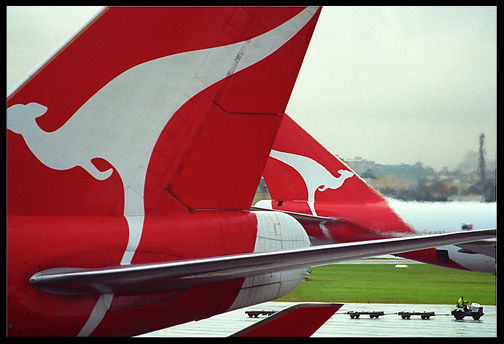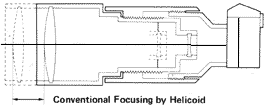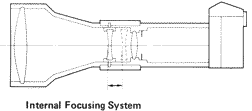 |
The fascination of a telephoto lens is in its ability to pull in a distant scene without being close to the subject. You can get truly dramatic frame filling shots of almost everything. Further, in comparison to wideangle or normal lenses, given a constant focusing distance value, telephoto lenses have inherently less depth of field at each f/stop. Selecting wider aperture will easily make subject stand out from background in bold relief. This is often called "selective focus". |
These lenses adds to your ability to control the appearance of the final image. Compared with a wide-angle lens that covers a tremendous-subject area, a normally "short" 300mm telephoto lens can be good enough to reach out distant to magnify the subject while with clever use of depth of field and narrow picture angle, eliminates distracting elements in the photograph. Most people would regard 300mm focal length as the end of "normal" telephoto lenses and starting point for a true super-telephoto range. To classify it under short super telephoto lenses category is more appropriate, as super-telephoto lenses above 400mm have some other optical characteristic and further, those long range lenses are generally quite difficult to handle. Physically, other than size and dimension - the telephoto lenses (except Reflex lenses) can be easily recognized with a quick visual identification by verifying at the entrance and exit pupils of a lens, as telephoto lenses usually have larger entrance pupils than normal and wideangle lenses.
 |
<<< --- A typical Nikkor super-telephoto lens such as this Nikkor 300mm f/2.8 EDIF is big, bulky but assuring of its reach with its long focal length and superlative image quality with the use of ED glass in its optical design, its is responsive in handling with an IF system, NIC coating provides a faithful reproduction of color, other features includes rear drop-in filter, preset focus design, has a rotable tripod collar and a handy external Snap-On lens hood. |
Nikon has a long history of producing high quality telephoto lenses. They have been design and making those lenses for their rangefinder Nikon cameras dated back to the '50. For an intsance, there were already three short mount lenses beyond the 180mm focal length introduced pre-1955 with Nikkor-Q 25cm f/4.0 (1951), Nikkor 35cm f/4.5, and two exotic Relfex-Nikkor 50cm f/5.0 and Reflex-Nikkor 100cm f/6.3 which all of these lenses required the use of an external focusing aid and primarily designed for the rangefinder Nikon but redesigned with a F-mount to be used on early Nikon F, Nikon F Photomic T, Tn and Nikkormat cameras. Needless to say, the early versions of Nikkor telephoto lenses required tedious setup in order to use them, they are bulky and mostly aimed to serve needs rather than intended to shine in quality.
 |
The first batch of true super telephoto Nikkor lenses designed specifically in Nikon F bayonet lens mount were only being introduced in 1964 - Nikkor 400mm f/4.5, Nikkor 600mm f/5.6, Nikkor 880mm f/8.0 and a Nikkor 1200mm f/11 lenses (Nikkor 300mm f/4.5 was introduced later). As these early lens type contain only optic (880mm and 1,200mm have manual diaphragms), an accessory Focusing Unit and automatic aperture diaphragm operation (cannot be used with the longest 1200mm due to vignetting but the later AU-1 was compatible). |
These arrangement has an advantage of able to reduce the bulkiness and weight, making them less expensive, more convenient to carry around and maintain interchangeability among few of these long lenses. These lenses evolved along with major optical development of Nikkor lenses, where most of them lasted until 1976/77 and slowly replaced with a modern direct mounting system instead of making use of the Focusing Unit. These are a few types of such Focusing Unit*, Nikon AU-1 ("AU" stands for Aperture Unit) which uses standard 52mm filter inside the unit and conventional Focusing Unit which uses 122mm filter attached to the front of each lens. So, telephoto lenses beyond the 300mm focal length prior to 1977 in the used market may require you to take extra precaution in order to avoid confusion with those lenses of modern design.
 |
As Nikon has always been commanding a leading role at the professional users' market; which can also be interpreted as the most demanding group of users for imaging hardware; the Company was believed to have been putting in a great deal of effort in the lens research and development in order to enable such leading edge be prolonged. In fact, many of such resulting effort from those days are still being used in the design and production of Nikkor lenses today. |
Credit: Flying Roos .. Brisbane Air Port, Australia. Nikkor 400mm f/4.5 ED Image courtesy of Mr. CY Leow <cyleow@paradise.net.nz>Image copyright © 2002 All rights reserved.
By mid '70, many new series of Nikkor super telephoto lenses were slowly phasing out older versions. For an example, some of the Nikkor telephoto lenses above 400mm encompasses some of the best Nikkor optical innovations within; some original effort, such as the adoption of Extra Low Dispersion (ED) glass in optical design and Nikon exclusive NIC (Nikon Integrated Coating process) have been used throughout to ensure images of brilliantly crisp images with excellent color rendition and virtually all these lenses have incorporated an Internal Focusing System (IF) to ensure there is no physical extension of the lens barrel throughout its focusing range where previously, traditionally heavy, bulky Helicoid system was often used in those older versions of Nikkor super telephoto lenses. Frankly, many of the lenses actually share a great deal of similarities with Nikkor telephoto lenses of shorter focal length except some key features were being used more extensively. These Nikkor super telephoto lenses are characterized to have extremely narrow angle of view of just a few degrees with depth of field almost limited to the plane of focus, unless stopped down to their minimal departure which usually being designed to provide f/22 or f/32.
OFF TOPIC SUPPLEMENTS:
 |
Credit: Image(s) displayed herein courtesy of all the nice folks from Taiwan's Digitize-Future@EBAY®. Some of them are extracted from their very popular online EBAY STORE. The Company also has a website on their own at shueido.com Image(s) copyright © 2006. All rights reserved. Please respect the visual property of the contributing photographer. |
 |
<<< --- Virtually all modern large aperture Nikkor telephoto lenses are provide with a handy carrying metal case as standard accessory which seems to be solid enough to withstand bumps and knocks, it is air tight and sufficiently well rain seal which is also good protective tool for transport via airliner. That was a well thought out and considerate enough to shield such an expensive investment. |
Whatever it is, there is no denying fact that with
the introduction of autofocus technology both in camera and lenses, photography with
telephotography is never the same again. The sheer speed and accuracy provides is
simply incomparable with traditional way of manual focus photography. Other than
in its various photographic applications. In fact, many camera/lens manufacturers
have also make use of their range of super-telephoto lenses to exhibit their latest
fruitful research from respective AF technologies on camera/lenses. As all of these
exotic, expensive lenses which is beyond most general consumers' purchasing power
are packed with the best of technologies within from respective makers. Nikon's current
range is "AF-S" series of lenses which was evolved from earlier emulated
attempt of "AF-I" series from Canon EF's USM technology. While this section
is still confined to Manual Focus range of Nikkor super telephoto lenses and the
AF section will be addressed in chapters to come.
Nikkor
Super Telephoto Lenses -
|
300mm | 400mm | 500mm | 600mm | 880mm | 1200mm | Reflex - 500mm 1000mm 2000mm
| Message Board |
for
your Nikkor
Optics
in a shared environment
| Message
Board
| Specifically for Dispose or Looking for new/used Nikon/Nikkor
photographic equipment
| Nippon Kogaku Rangefinder Resources | Nikon F | Nikon F2 | Nikon F3 | Nikon F4 | Nikon F5 | Nikon F6 | Nikkormat / Nikomat | Nikon FM Series | Nikon FE/ FA | Nikon EM/FG/FG20 | Nikon Digital SLRs | Nikon - Other models |
Nikon MF RF-Nikkor lenses for Rangefinder
cameras:-
Main Index Page
Nikon
Auto Focus Nikkor lenses:- Main
Index Page
Nikon
Manual
Focus
Nikkor lenses:-
Fisheye-Nikkor Lenses - Circular |
Full Frame |
Ultrawides Lenses - 13mm15mm18mm20mm |
Wideangle Lenses - 24mm28mm35mm |
Standard Lenses - 45mm 50mm 58mm | Telephoto Lenses
- 85mm105mm135mm180mm & 200mm |
Super-Telephoto Lenses - 300mm 400mm 500mm 600mm 800mm 1200mm |
 |
Special Application
lenses: Micro-Nikkor Lenses - 50mm~55mm -60mm 85mm -105mm 200mm Micro-Zoom 70-180mm Perspective Control (PC) - 28mm 35mm PC-Micro 85mm Dedicated Lenses for Nikon F3AF: AF 80mm f/2.8 | AF 200mm f/3.5 EDIF Depth of Field Control (DC): 105mm 135mm Medical Nikkor: 120mm 200mm Reflex-Nikkor Lenses - 500mm 1000mm 2000mm Others: Noct Nikkor | OP-Nikkor | UV Nikkor 55mm 105mm | Focusing Units | Bellows-Nikkor 105mm 135mm Nikon Series E Lenses: 28mm35mm50mm100mm135mm | E-Series Zoom lenses: 36~72mm75~150mm70~210mm |
MF Zoom-Nikkor Lenses: 25~50mm | 28~45mm | 28~50mm | 28~85mm | 35~70mm | 36~72mm E | 35~85mm | 35~105mm | 35~135mm | 35~200mm | 43~86mm | 50~135mm | 50~300mm | 70~210mm E | 75~150mm E | 80~200mm | 85~250mm | 100~300mm | 180~600mm | 200~400mm | 200~600mm | 360~1200mm | 1200~1700mm
Tele-Converters: TC-1 | TC-2 | TC-200 | TC-201 | TC-300 | TC-301 | TC-14 | TC-14A | TC-14B | TC-14C | TC-14E | TC-16 | TC-16A | TC-20E
Recommended links to understand more technical details
related to the Nikkor F-mount and production Serial Number:
http://rick_oleson.tripod.com/index-153.html by: my
friend, Rick Oleson
http://www.zi.ku.dk/personal/lhhansen/photo/fmount.htm by: Hansen,
Lars Holst
http://www.mir.com.my/rb/photography/hardwares/nikonfmount/lens2.htm
http://www.photosynthesis.co.nz/nikon/serialno.html
Recommended Reading Reference on Nikon cameras and Nikkor lenses | about this photographic web site
| | Back | Main Index Page of Nikkor Resources | Back | Main Index Page of Pictorial History of Nikon SLRs |
| Home - Photography in Malaysia |
![]() Co-developed
with my web buddy, Rick Oleson® &
Co-developed
with my web buddy, Rick Oleson® & ![]() Denmark, Creator of the Nikon
Repair Group Mailing-List;
A
contributing effort to Michael Liu's Classic Nikon SLRs and
Nikkor optic site.
Denmark, Creator of the Nikon
Repair Group Mailing-List;
A
contributing effort to Michael Liu's Classic Nikon SLRs and
Nikkor optic site.
Credit: MCLau®, who has helped to rewrite
some of the content appeared this site. Chuck Hester® who has been helping
me all along with the development of all these Nikon websites; Lars Holst Hansen, 'Hawkeye'
who shares the same passion I have; Ms Rissa, Sales manager
from Nikon Corporation Malaysia for granting permission to use some of the official
content; Ted Wengelaar, Holland
who
has helped to provide many useful input relating to older Nikkor lenses; Some of the references
on production serial numbers used in this site were extracted from Roland Vink's website; Hiura Shinsaku from Nikomat
Club Japan. Lastly,
to all the good people who has contributed their own expeience, resources or kind
enough granted permission to use their images of their respective optic in this site.
It is also a site to remember a long
lost friend
on the Net. Note:certain content and
images appeared in this site were either scanned from official marketing leaflets
& brochures published by Nikon and/or contribution from surfers who claimed originality
of their work for educational purposes. The creator of the site will not be responsible
for may discrepancies arise from such dispute except rectifying them after verification. "Nikon", "Nikkormat", "Nippon Kokagu
KK"
& "Nikkor" are registered
tradename of Nikon Corporation Inc., Japan. Site made with an Apple IMac.

